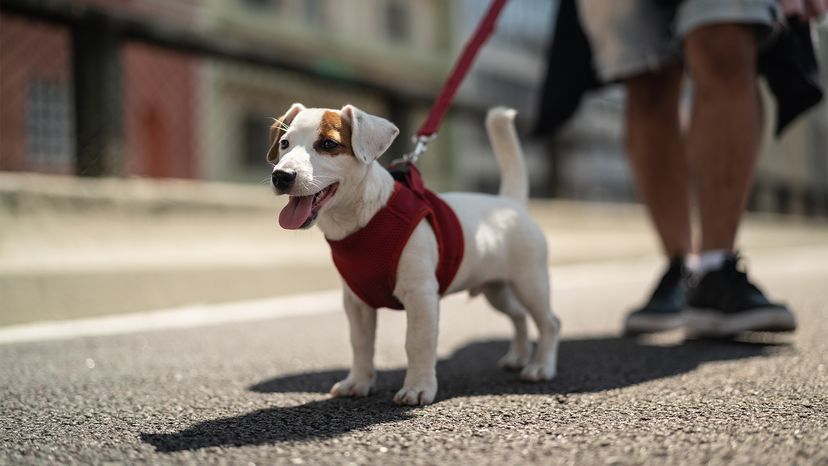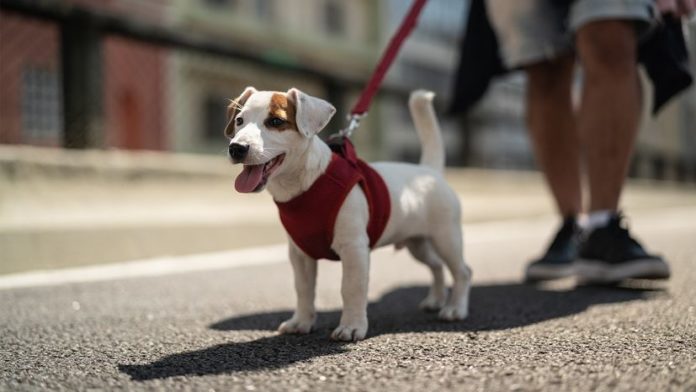 “Leash, collar and harness is one basic setup for a successful walk in the park, but there are lots of not-so-great choices out there for each. FG Trade/Getty Images
“Leash, collar and harness is one basic setup for a successful walk in the park, but there are lots of not-so-great choices out there for each. FG Trade/Getty Images
Aww … you got a puppy. Bet you’re looking forward to lots of fun days playing with her, taking walks. Feeding her, teaching her to roll over, taking walks. Cuddling on the couch with her and, yes, taking walks. Are you sensing a theme?
Dogs require a lot of walks. The obvious reason is because they have to go out to "do their business," meaning urinate and defecate. The frequency depends on the breed, but if you live in an apartment or a house without a fenced yard where they can roam freely to take care of the call of nature, as the adult in the room you’re responsible for taking them out to a designated area (hopefully not your neighbor’s yard) where they can "go."
But there’s more to it than that. Dogs need lots of exercise. They need to burn off energy and socialize with other dogs (hello dog park!). Walks are an important part of your dog’s daily routine, and that means your pup’s leash is a crucial canine accessory. Have you ever Googled the phrase "best dog leash"? We did and got more than 144 million results. In the interest of narrowing the results, we talked to an expert about her favorite leash and why she recommends it.
Leashes to Avoid
Susie Aga is a nationally recognized dog trainer, an expert in dog behavior modification and the founder of Atlanta Dog Trainer. She has decades of dog training experience and has clear preferences about leashes. Aga says she never recommends a retractable leash.
"They’re very popular leashes but everyone hates them," she says. "It’s irritating for the dogs on the leash, they’ve got constant tension on them, and it’s irritating for humans in the community. Most pet owners don’t reel in their dogs. They just let them wrap up whoever’s walking by."
Aga’s right. Retractable leashes are dangerous to dogs (and humans). How many times have you been strolling along in the park minding your own business when suddenly there’s a Doberman pincher staring at you a good 20 to 30 feet (6 to 9 meters) away from its owner?
Aga also doesn’t like the slip lead, which is basically a slip knot allowing you to slip your dog’s head through the loop and pull to tighten (think of those leashes you get at the vet). But they can be very dangerous. "I don’t like them because it puts a lot of pressure on the dog’s trachea and can cause a lot of damage," she says. "I think they’re terrible."
Leashes to Go With
Aga’s leash recommendation is a basic 6-foot (1.8-meter), braided leather leash with brass fittings that clips onto the dog’s collar or harness, whichever the dog wears when walking. Aga says 6 feet is plenty long for every breed of dog to get away to use the bathroom. The only time she doesn’t recommend the brass fittings is for small dogs because the brass clasps can be too heavy. Try stainless steel or aluminum fittings instead.
"Leather leashes last a really long time," she says. "I’ve got one leash that’s 15 years old. That’s not an exaggeration."
When you look at the lists of the "Top 10 Leashes for Dogs" you’ll be hard-pressed to find a braided leather leash. Most are made of reinforced nylon or cloth webbing. Some even have carbon fiber woven into them. Others are made of nylon rope. Aga says those are fine, but prepare to keep buying them.
Is a Harness or Collar Better?
"Nylon leashes, even the ones that are sturdy webbing, are fine but they don’t last as long as leather," she says. "Dogs can chew through them and then the owners end up tying them in knots. There’s a lot of stuff in the dog world designed to make you buy more. As a trainer, I want something that’s going to last a long time."
Aga says all dogs should wear collars, where their tags are located. The leash clips onto the collar. Some dog breeds, large ones like Siberian huskies or Bernese Mountain dogs or much smaller ones such as toy breeds or puppies benefit from wearing harnesses when then go for walks. They’re good for dogs who pull a lot, too.
"Harnesses are designed so there is less pulling," says Aga. "Front clip harnesses seem to work best for that. You don’t want to put a lot of pressure on the trachea of a small breed. So, a lot of toy breeds will use harnesses rather than a collar because of how small they are."
Now That’s Interesting
A martingale collar is a popular collar that’s considered safer than a slip collar or choke chain. A martingale is comprised of a large loop connected to a small loop. The dog’s head slips inside the larger loop and the leash is attached to the small loop. When the dog pulls, the large loop tightens slightly, but not enough to choke the dog.








































